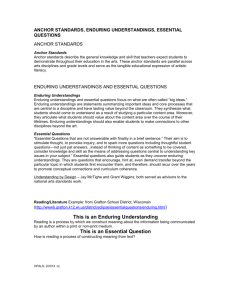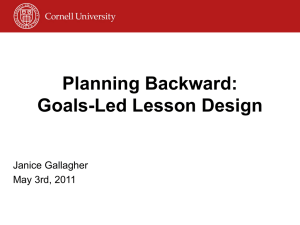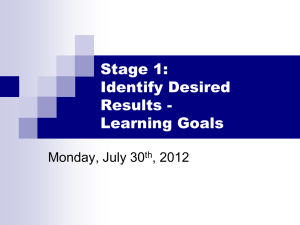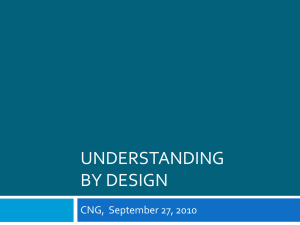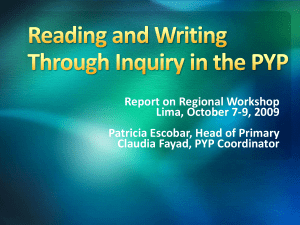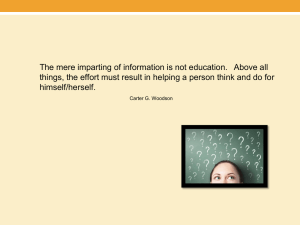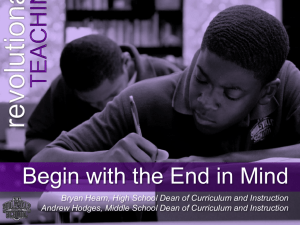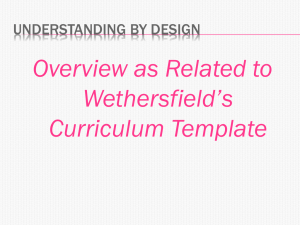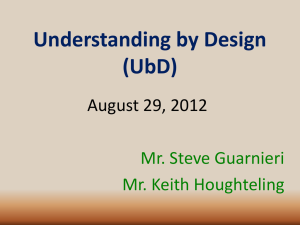Understanding By Design
advertisement
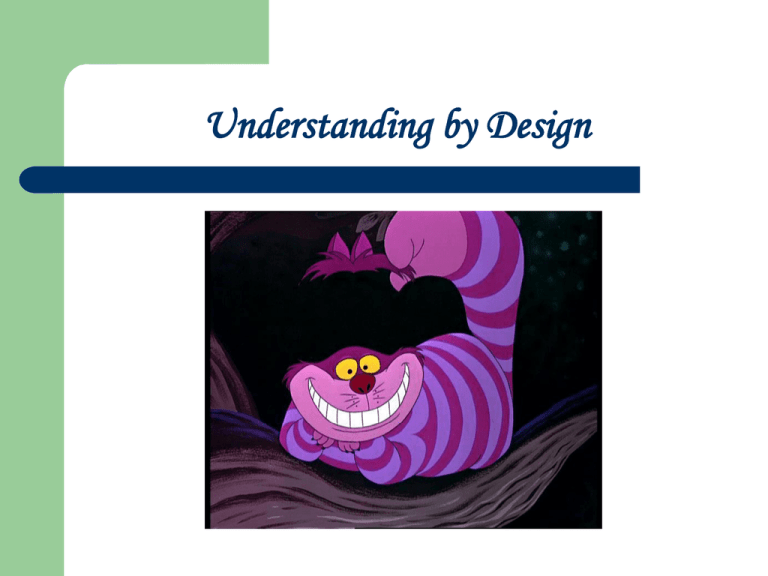
Understanding by Design Why Use Backward Planning? Alice in Wonderland Alice is lost. "Which way should I go?" After a moment of silence, the Cheshire Cat said, "That depends. . ." Alice said, "Depends on what?" The Cat said: "It depends on your destination. Where are you going?" "I don’t know. . . I just don’t know. . ." answered a confused Alice. "Then," said the Cheshire Cat, while grinning broadly, "It really does not matter." Understanding by Design… To begin with the end in mind means to start with a clear understanding of your destination. It means to know where you’re going so that you better understand where you are now so that the steps you take are always in the right direction. Stephen R. Covey Understanding By Design Grant Wiggins and Jay McTighe Understanding by Design a conceptual framework, design process and template, and an accompanying set of design standards. a methodology to design or redesign any curriculum to increase student understanding. Understanding By Design Grant Wiggins and Jay McTighe 3 Stages 1. Identify Desired Results 2. Determine Acceptable Evidence 3. Plan Learning Experiences The “Design” Approach: Stage 1: What essential outcomes are worthy and requiring of understanding? Stage 2: What would be evidence of enduring understanding? Stage 3: What teaching and learning experiences promote, foster, and support understanding, interest, and excellence? 6 April Break!! Let’s “Design” a vacation!! What should we decide first? Other important factors? Understanding by Design Big Ideas (established goals, content standards, learning outcomes) Are defined by Enduring Understandings + Essential Questions 8 Big Ideas =Enduring Understandings + Essential Questions “Big Ideas”- anchor understandings – – – – are broad, abstract, universal, timeless connect and organize important ideas, skills and facts are conceptual, thematic, theoretical Courage, friendship, justice, evolution, diversity, loyalty, acceptance, rejection. 9 Understanding by Design Big Ideas =Enduring Understandings + Essential Questions Enduring Understandings – What do we want learners to understand, know, and be able to do several years from now, once they have forgotten the details? 10 Understanding by Design Big Ideas =Enduring Understandings + Essential Questions Enduring Understanding: – – – – defines core ideas and processes central to a discipline or concept (Big Idea) transferable to other content and contexts enduring value beyond the classroom 11 Understanding by Design Big Ideas =Enduring Understandings + Essential Questions Enduring Understanding: – – – – summarizes strategic skills and principles Assessed through performance tasks incorporates realistic contexts and real-world problems and solutions Students apply knowledge and skills to a new situation 12 Understanding by Design Big Ideas =Enduring Understandings + Essential Questions "It is not possible to be a good thinker and a poor questioner." ` Richard Paul and Linda Elder Essential Questions: – – – – requires the student to develop a plan or course of action. requires the student to make a decision. are powerful, directive and commit students to the process of critical thinking through inquiry. the answer to the essential question will require that students craft a response that involves knowledge construction. ** Answers to essential questions are a direct measure of student understanding. 13 Understanding by Design Big Ideas =Enduring Understandings + Essential Questions Essential Questions: – – – – reside at the top of Bloom's Taxonomy (Bloom, 1954). require students to EVALUATE (make a thoughtful choice between options, with the choice based upon clearly stated criteria), to SYNTHESIZE (invent a new or different version) to ANALYZE (develop a thorough and complex understanding through skillful questioning). 14 Understanding by Design What Should Your Students Know? After 40 days – facts/ surface knowledge (worth being familiar with Measured by: Tests/quizzes) After 40 months – Favorite part/character from a book (important to know and do – Measured by: performance tasks/projects) After 40 years – Morals, Enduring Understandings (Standards, program objectives, learning outcomesMeasured by: complex- open ended, authentic assessments) Establishing Curricular Priorities Understanding by Design Designing Units Look at standards prior to developing units (2-3 weeks in length) This will help focus on Big Ideas (themes) and Enduring Understandings eg Understanding by Design Stage 1 : Identify Desired Results What do I want the students to know and be able to do? Big Ideas – Themes based upon standards 1. 2. ENDURING UNDERSTANDINGS: Charlotte’s Web ESSENTIAL QUESTIONS: Students will understand how reading relates to life experiences by analyzing and comparing the emotions, feelings, and actions of characters to their own experiences. Students will understand the difference between cause and effect and how cause and effect can influence life choices. Charlotte’s Web How, Why, To what extent: (No more than 5 per unit) 1. 2. How do some of the experiences of the characters in Charlotte’s Web relate to some of your own personal experiences? How does cause and effect influence some of the events and outcomes in Charlotte’s Web? Understanding by Design Stage 1 : Identify Desired Results What do I want the students to know and be able to do? Big Ideas – Themes based upon standards ESSENTIAL QUESTIONS: ENDURING UNDERSTANDINGS: How, Why, To what extent: (No more than 5 per unit) Hamlet Hamlet 1. In Hamlet, Shakespeare explores many issues of the human condition that are still relevant today. 2. People respond to a crisis situation in a variety of ways that reveal much about human psychology and experience. 3. As is true with most matters of the heart, revenge is not always as cut and dry as we might like it to be. 4. Ghosts of the past haunt people in many ways that affect their decision. 1. 2. 3. 4. Why study an old book like Hamlet? How do people respond in a crisis? Is revenge okay? Why or why not? To what extent do ghosts of the past haunt us? Understanding by Design Stage 2: Assessment Evidence Performance assessment tasks will measure enduring understandings. Continuum of Informal & Formal Assessment Instruments Traditional Content-Focused Assessments – tests/quizzes Authentic, Open-Ended Performance Tasks and Projects Sound assessment requires multiple snapshots over time. Understanding vs. Knowing http://cooperativelearning.nuvvo.com/lesson/9592-seinfeldteaches-history Six Facets of Understanding UNDERSTANDING Understanding by Design Stage 2: Six Facets of Understanding “A list of ingredients, but not yet dinner” How do we get students to think? To Learn? These facets mutually reinforce the concept of student understanding How do we know they understand? … - the more we see a student explain, identify, apply, and offer multiple points of view on the same idea, the more likely that the student understands that idea. Understanding by Design Stage 3: Learning Plan Instructional strategies and learning experiences to achieve the desired result WHERETO: W - Where are we going? Why? What? H – Hook the students interests E – Equip students for the Performance Task R – Help students to rethink and revise E – Students self-evaluate their learning T – Tailor learning to varied needs O – organize the sequence of learning Understanding by Design Stage 3: Learning Plan Individual lesson plans are constructed in stage 3 Ensure that Big Ideas are uncovered through inquiry activities and explicit instruction Help learners to make sense of content Connect facts to skills to large ideas Apply knowledge I meaningful ways April Vacation - Conclusion What is the “BIG IDEA” What are the “essential questions” What are the “enduring understandings?” References: Wiggins, G., & McTighe, J. (1998). Understanding by design. Alexandria, VA. Association for Supervision and Curriculum Development Wiggins, G., & McTighe, J. (2004). Understanding by design: Professional Development Workbook. Alexandria, VA. Association for Supervision and Curriculum Development Wiggins, G., & McTighe, J. (2005, 2nd Edition). Understanding by design. Alexandria, VA. Association for Supervision and Curriculum Development (http://www.fno.org/sept96/questions.html) 27 Understanding By Design THE END


